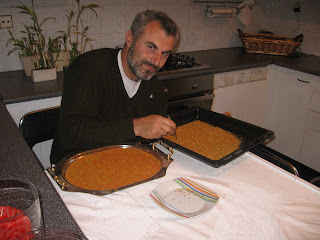Ξεκινάμε δυναμικά και φέτος!!
Μετά από μια καλή διεγερτική τροφοδότηση τον τελευταίο μήνα και μια καλή διαίρεση στα δυνατά μελίσσια μας , είμαστε έτοιμοι να υποδεχτούμε και αυτήν την μελισσοκομική χρονιά!
Βασικά ξεκινήσαμε με μια σπέσιαλ βασιλοτροφια για να τροφοδοτήσουμε τα αδύνατα αλλά και τα νέα μελίσσια μας με δυναμικούς «πρώτους» (βασίλισσες).
Στην πορεία τοποθετήσαμε μερικές γυρεοπαγιδες για της ανάγκες δικέ μας αλλά και μερικών καλών φίλων, δεν κάνω μεγάλο άνοιγμα προς το παρών πάνω σε αυτό το θέμα διότι ακόμα ο κόσμος δεν γνωρίζει την δύναμη της γύρης!!!
Κατά ένα περίεργο τρόπο τα μικρά τα δικά μου αλλά και τα γειτονάκια , όταν ακούνε ότι θα πάω στης μέλισσες για να μαζέψω γύρη………. παθαίνουν πανικό!!!!!!!!!! πανηγύρι σωστό στήνετε!!! Μπορεί να παρακαλώ της κόρες μου να μου φέρουν ένα ποτήρι νερό ( άλλες φορές τις απειλώ με διάφορες τιμωρίες!!! )αλλά όταν ακούνε μάζεμα γύρης τρελαίνονται ποια θα πάει να την μαζέψει!!!! Δεν μπορώ να το καταλάβω αυτό!!!
Έτσι και σήμερα πήρα και την φωτογραφική μηχανή μαζί μου για να το αποθανατίσω αυτό το γεγονός!!!
Μαζί μας βέβαια και η σοραγια!!! Η σκυλίτσα της γειτονιάς ….. καλύτερα να έλεγα ο συναγερμός της γειτονιάς μας, όσο μπόι της λείπει τόση καρδιά έχει!! Δεν μπαίνει κανείς στο αδιέξοδο στενό μας χωρίς να σημάνει συναγερμός!!! Άσε που πηγαίνει και φέρνει όλα τα γειτονάκια στα φροντιστήρια και στα σχολεία παρέα!!
Επί το έργο και …….χωρίς κουκούλες!!!!!!!!
Μετά από δυο μέρες φυσικού στεγνώματος πάνω σε δίσκους και ταψιά της κυράς Τασούλας (καταλαβαίνετε τι μουρμούρα επικρατεί!!). Αρχίζει το καθάρισμα από τα διάφορα ξένα σώματα, και μετά πορεία για τον καταψύκτη!!
Μια λεπτομέρεια εδώ…… δεν την βάζω κατευθείαν στην κατάψυξη διότι είναι μέσα της παρά πολλά μερμήγκια!! Μετά από δυο μέρες την έχουν κοπανίσει όλα και είμαι πολύ πιο άνετος για το ξεκαθάρισμα!











